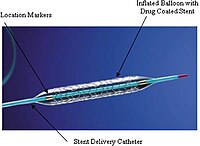
Photo from wikipedia
Background Despite the theoretical benefits of biodegradable polymer drug-eluting stents (BP-DES), clinical benefits of BP-DES over durable polymer DES (DP-DES) have not been clearly demonstrated. Using data from a large-volume… Click to show full abstract
Background Despite the theoretical benefits of biodegradable polymer drug-eluting stents (BP-DES), clinical benefits of BP-DES over durable polymer DES (DP-DES) have not been clearly demonstrated. Using data from a large-volume nationwide cohort, we compared long-term clinical outcomes between BP-DES- and DP-DES-treated patients. Methods A retrospective cohort study that enrolled all patients who underwent percutaneous coronary intervention (PCI) with new-generation DES between 2010 and 2016 in Korea was conducted by using the National Health Insurance Service database. The outcomes of interest were all-cause death, cardiovascular death, and myocardial infarction (MI). Results A total of 127,731 patients treated with new-generation DES with thin struts (<90 μm) were enrolled for this analysis. After stabilized inverse probability of treatment weighting, the incidence of all-cause death was significantly lower in patients treated with BP-DES (n = 19,521) at 5 years after PCI (11.3 vs. 13.0% in those treated with DP-DES [n = 108,067], hazard ratio [HR] 0.92, 95% confidence interval [CI], 0.88–0.96, p < 0.001), while showing no statistically significant difference at 2 years after PCI (5.7 vs. 6.0%, respectively, HR 0.95, 95% CI, 0.89–1.01, p = 0.238). Similarly, use of BP-DES was associated with a lower incidence of cardiovascular death (7.4 vs. 9.6% in those treated with DP-DES, HR 0.82, 95% CI, 0.77–0.87, p < 0.001), and MI (7.4 vs. 8.7%, respectively, HR 0.90, 95% CI, 0.86–0.94, p = 0.006) at 5 years after PCI. There was no statistically significant difference of cardiovascular death (4.6 vs. 4.9%, respectively, HR 0.93, 95% CI, 0.85–1.01, p = 0.120) and MI (5.0 vs. 5.1%, respectively, HR 0.98, 95% CI, 0.92–1.05, p = 0.461) at 2 years after PCI. Conclusions Implantation of BP-DES was associated with a lower risk of all-cause death, cardiovascular death, and MI compared with DP-DES implantation. This difference was clearly apparent at 5 years after DES implantation. Clinical Trial Registration ClinicalTrial.gov, NCT04715594.
Journal Title: Frontiers in Cardiovascular Medicine
Year Published: 2022
Link to full text (if available)
Share on Social Media: Sign Up to like & get
recommendations!